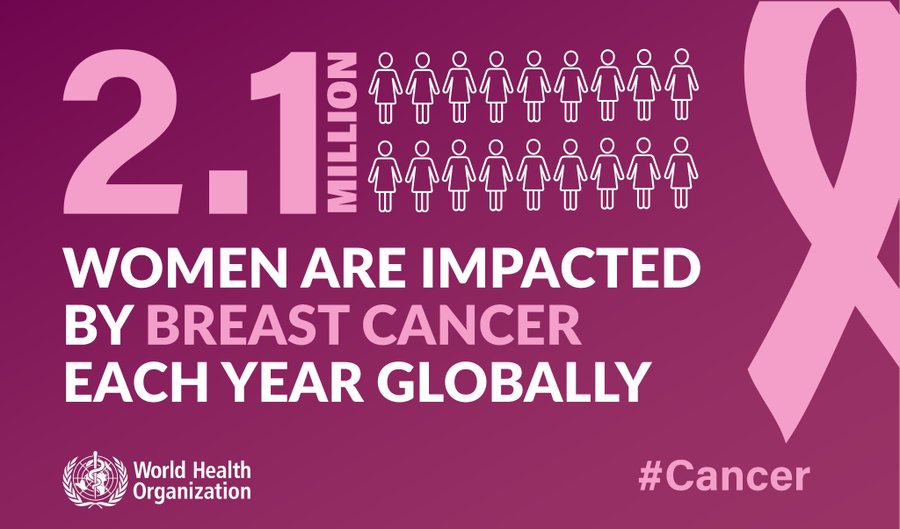
Breast cancer is the most frequent cancer among women, impacting
2.1 million women each year, and also causes the greatest number
of cancer-related deaths among women. In 2018, it is estimated that 627,000 women died from breast cancer – that is approximately
15% of all cancer deaths among women. While breast cancer rates
are higher among women in more developed regions, rates are
increasing in nearly every region globally.
In order to improve breast cancer outcomes and survival, early
detection is critical.
There are two early detection strategies for breast cancer: early diagnosis and screening. Limited resource settings with weak health systems where the majority of women are diagnosed in late stages should prioritize early diagnosis programmes based on awareness of early signs and symptoms and prompt referral to diagnosis and treatment.

Early diagnosis
Early diagnosis strategies focus on providing timely access to cancer treatment by
reducing barriers to care and/or improving access to effective diagnosis services.
The goal is to increase the proportion of breast cancers identified at an early stage,
allowing for more effective treatment to be used and reducing the risks of death from
breast cancer. WHO Package of essential noncommunicable (PEN) disease
interventions for primary health care in low-resource settings has guidance on the
approach to assessment and referral for women with suspected breast cancer in
the primary care setting.

Screening
Screening consists of testing women to identify cancers before any symptoms appear. Various methods have been evaluated as breast cancer screening tools, including mammography, clinical breast exam and breast self-exam.
Mammography: uses low-energy X-rays to identify abnormalities in the breast. It has
been shown to reduce breast cancer mortality by approximately 20% in high-resource settings. WHO Position paper on mammography screening concluded that in
well-resourced settings women aged 50-69 should undergo organized,
population-based mammography screening if pre-specified conditions on programme implementation are met. In limited resource settings with weak health systems, mammography is not cost-effective, and early detection should focus on reducing stage
at diagnosis through improved awareness. For women aged 40-49 years or 70-75 years, WHO recommends systematic mammography screening in women aged
40-49 years or 70-75 years only in the context of rigorous research and in well-resourced settings.
Clinical Breast Exam (CBE): is an examination of both breasts performed by a trained health professional. CBE seems to be a promising approach for low resource settings
and could be implemented depending on the evidence from ongoing studies.
Because screening requires substantial investment and carries significant potential personal and financial costs, the decision to proceed with screening should be pursued
only after (1) basic breast health services including effective diagnosis and timely
treatment are available to an entire target group; (2) its effectiveness has been demonstrated in the region; and (3) resources are available to sustain the programme
and maintain quality.
https://www.who.int/cancer/prevention/diagnosis-screening/breast-cancer/en/

#BreastCancer is increasing particularly
in developing countries
where the majority of cases are diagnosed
in late stages. Early detection of#cancer greatly increases the chances for successful treatment.

_ https://www.who.int/cancer/detection/en/
foto by pinterest

by i-rena

Δεν υπάρχουν σχόλια:
Δημοσίευση σχολίου